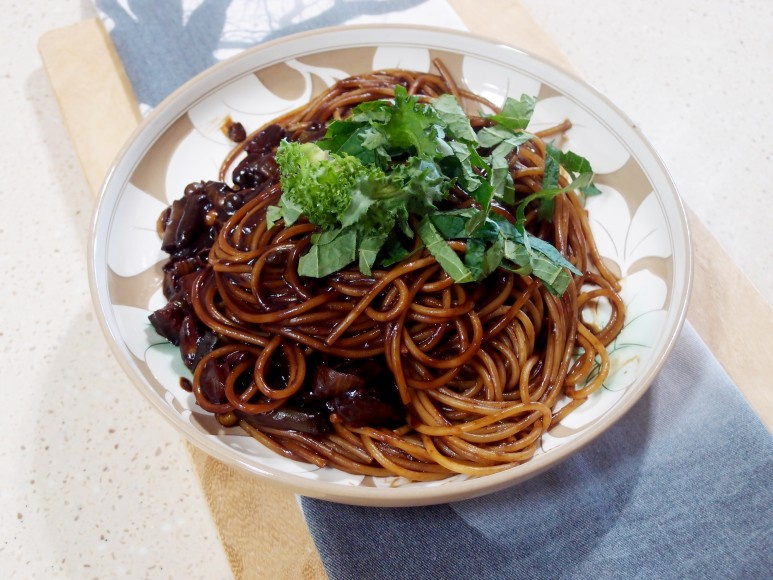Savory Jjajang Spaghetti
#JjajangPowderRecipe #EasyJjajangSauce #HomemadeJjajangPasta #FusionChineseCuisine #JjajangSpaghetti

Discover how to easily create a rich and flavorful Jjajang sauce at home using readily available Jjajang powder! This versatile sauce is perfect not only for delicious Jjajang-bap (rice with Jjajang sauce) but can also be used to make authentic Jjajangmyeon with Chinese noodles. For a spicy twist, add a touch of gochujang (red pepper paste) and gochugaru (red pepper flakes) to create a delightful Jjajang tteokbokki (spicy rice cakes). (Remember to adjust the Jjajang powder quantity for balanced seasoning!) Today, however, we’re elevating it beyond Jjajang-bap or Jjajangmyeon by infusing it with Italian pasta. Enjoy this delightful ‘Jjajang Spaghetti,’ a fusion dish where perfectly cooked spaghetti noodles are stir-fried in our simple yet incredibly flavorful homemade Jjajang sauce. It’s a guaranteed crowd-pleaser!
Jjajang Sauce Ingredients- 200g pork neck, cut into bite-sized pieces
- 1 onion, roughly chopped (or finely chopped according to preference)
- 250g frozen mixed vegetables (e.g., zucchini, carrot, peas)
- 4 Tbsp chopped white part of green onion
- 2 Tbsp minced garlic
- 1 Tbsp dried chili peppers (e.g., red pepper flakes or small dried chilies, adjust to taste)
- 1 tsp grated ginger
- 4 Tbsp chili oil
- 2 Tbsp sugar
- 1 Tbsp dark soy sauce (or regular soy sauce)
- 200g Jjajang powder
- 1 Tbsp chicken stock (or kelp broth)
- 1 Tbsp chili powder (optional, for extra spice)
- 700ml broth (or water)
Cooking Instructions
Step 1
First, prepare the onion, a key ingredient for the Jjajang sauce. You can chop it roughly for a more distinct texture in the sauce, or finely mince it for a smoother consistency, depending on your preference. Have your frozen mixed vegetables ready as well.

Step 2
Heat chili oil in a pan over medium-low heat. Add the dried chili peppers, chopped green onion, minced garlic, and grated ginger. Stir-fry gently until fragrant to create an aromatic oil base. This step is crucial for building a delicious foundation for the sauce.

Step 3
Add the sliced pork neck to the pan. Increase the heat to high and stir-fry, breaking up the meat so it doesn’t clump, until the pork is browned on all sides.

Step 4
When the pork is about halfway cooked, sprinkle the sugar evenly around the edges of the pan. Let it caramelize slightly, which adds a deep sweetness and rich flavor. Then, drizzle the dark soy sauce (or regular soy sauce) along the sides of the pan and stir-fry everything together. This process helps to infuse the ingredients with a smoky flavor and a beautiful sheen. Sautéing sugar first, then adding soy sauce around the pan edges, enhances the smoky aroma.

Step 5
Once the pork is fully cooked and has turned gray, add the prepared chopped onion and frozen mixed vegetables to the pan. Continue to stir-fry over medium heat until the vegetables are tender and the onions become translucent. The natural sweetness of the vegetables will meld with the pork for an even richer taste.

Step 6
After the vegetables have softened slightly, gradually add the Jjajang powder, sifting it over the ingredients to prevent clumps. Stir continuously with a spatula to ensure the powder dissolves evenly and coats all the ingredients. Fry for a few minutes until the characteristic savory aroma of the Jjajang powder is released and everything is coated in a rich brown color.

Step 7
If you desire a spicier kick, add 1 tablespoon of chili powder at this stage and stir-fry briefly with the Jjajang powder. At this point, the Jjajang sauce will become quite thick.

Step 8
Pour in the 700ml of broth (or water). Use your spatula to scrape any bits from the bottom of the pan, ensuring the Jjajang powder is well dissolved. Bring the sauce to a boil over high heat, then reduce to medium-low and simmer until it reaches a thick, rich consistency. Jjajang powder typically contains starch, so you usually don’t need to add extra cornstarch slurry, making sauce preparation very convenient.

Step 9
Your deep and flavorful Jjajang sauce is ready! If you were making Jjajang-bap, you would simply spoon this over hot rice and top with a fried egg. But today, we’re taking this delicious sauce and pairing it with Italian pasta for a special ‘Jjajang Spaghetti’ experience!

Step 10
Take a portion of the prepared Jjajang sauce and set it aside in a separate pan. Bring a large pot of salted water to a rolling boil for the spaghetti. Once the pasta is nearly al dente, turn on the heat under the pan containing the reserved Jjajang sauce to warm it up.

Step 11
Drain the cooked spaghetti and immediately add it to the pan with the warmed Jjajang sauce. Using tongs or a spatula, quickly toss and stir-fry the spaghetti to coat each strand evenly with the sauce. Continue to cook until the pasta is well-coated and the sauce reaches your desired consistency, then turn off the heat.

Step 12
The spaghetti, now coated in the rich Jjajang sauce, looks as enticing as freshly made Jjajangmyeon noodles. Transfer the Jjajang Spaghetti to a serving plate. Pile the noodles attractively and then generously spoon over any remaining sauce.

Step 13
Experience the delightful fusion of our simple Jjajang sauce and Italian pasta! Your ‘Jjajang Spaghetti,’ a unique Chinese-inspired pasta dish, is now complete. For a final touch, sprinkle the thinly julienned perilla leaves over the top. Their fresh aroma and vibrant green color add a beautiful contrast and an extra layer of flavor. (Alternatively, you can use julienned cucumber. A fried egg might not be the best accompaniment for Jjajang Spaghetti, in my opinion!)




